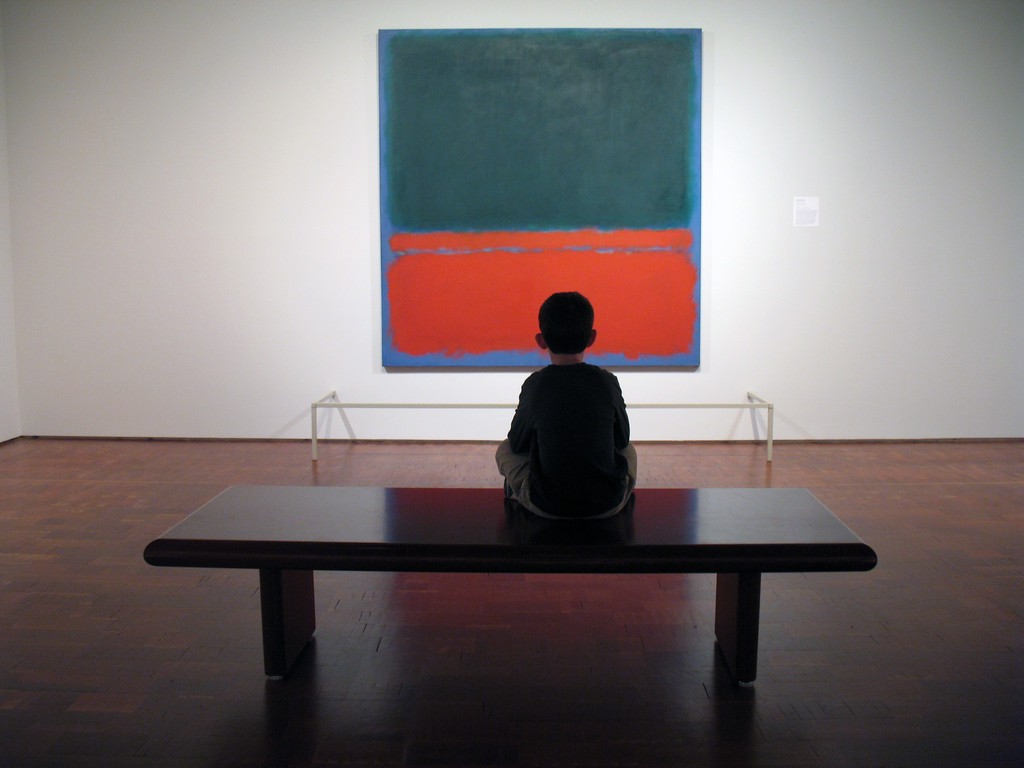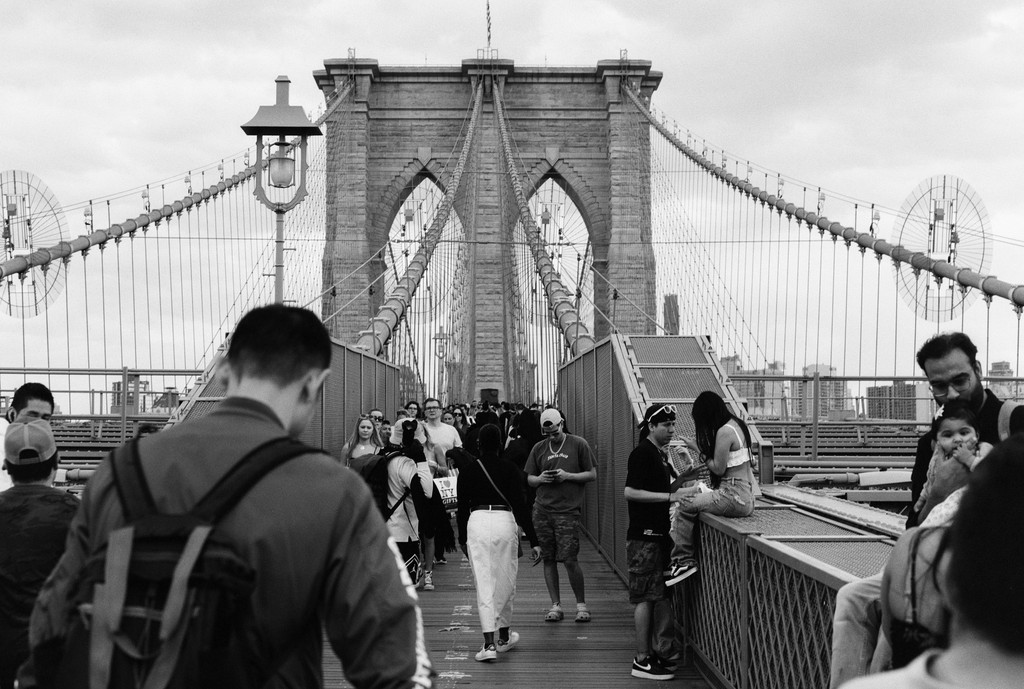Who Is an Artist?
Table of Contents
Yesterday, I took a walk to the Brooklyn Bridge, a notorious tourist trap but also a beautiful and marvelous feat of engineering. I wanted to photograph it (a cliché, I know) so I can make a print for someone as a gift. Hours passed in what felt like minutes. This experience, this immersion in creation for its own sake, is what makes me call myself an artist. So when a friend of mine–who reads this blog–made an off-hand comment critical of the fact that I call myself an artist, I wasn’t offended, but it did get me thinking about: who is an artist? What makes someone an artist? Is it enough to just make art? Do you have to show it? Sell it? Call yourself an artist on your LinkedIn profile?
I think one definition I like is quite simple: an artist is someone who makes art. What then, is art? I think my favourite definition comes from none other than Jeremy Clarkson, who once defined it as anything that exists for no other purpose than being art. In other words, an advertisement may contain art, but the ad itself is not art. A car may be a work of art, but its primary purpose is to get you from point A to point B. A painting may be art, but if it’s just a paint-by-numbers exercise, is it really art?
This perspective resonates with me because it focuses on intention rather than execution. Art emerges from the desire to create something expressive that serves no utilitarian function beyond its own existence. When we create without practical purpose, we enter the realm of art.
The Historical Shifting of Artistic Identity #
What we consider an “artist” has transformed dramatically throughout history. In medieval times, those who created what we now consider masterpieces were often viewed as skilled craftspeople rather than cultural icons. They worked in workshops, fulfilled commissions, and were valued for their technical abilities rather than their personal expression.
The concept of the artist as a special category of person with unique sensibilities emerged primarily during the Romantic era. This shift elevated the artist to a cultural figure whose personal vision and emotional depth became central to the value of their work. This historical context shows us that our current definition isn’t fixed or universal—it’s a cultural construct that continues to evolve.
Gatekeeping Artistry #
Some might argue that you aren’t an artist unless you have a job title that is of a respectable Artistic Profession (whatever that means). Perhaps you’re not an artist unless you’ve sold a piece of work. Perhaps you’re only an artist if you make the kind of art that I like, or that some official Art Curator has deemed is worthy of the title.
This kind of gatekeeping is unhelpful and ultimately damaging. It discourages people from making art, while I firmly believe we should all make art. You don’t need to make art for anyone but yourself. You never need to exhibit your work, nor should you feel the need to sell it, or seek validation from others. The only thing that matters is that you made the art, and ideally you’re proud of your work. Even if you don’t like it (I personally loathe my own work most of the time), it doesn’t matter. The act of creating is what makes you an artist.
These external validations—sales, exhibitions, degrees, or critical acclaim—might bring certain advantages, but they don’t confer artistic identity. They simply represent different ways art interfaces with social and economic systems. Many of history’s most celebrated artists received little recognition during their lifetimes, while some commercially successful creators may leave minimal lasting impact. The correlation between external validation and artistic significance is far weaker than conventionally assumed.
Art Is What You Make of It #
You can decide what art means to you, and you can decide what medium you choose to express yourself with. The medium doesn’t matter so much as the subject, intent, and the process of creating. If anything, I think the most important thing about being an artist is the process of creating. It’s not even about the final result, it’s more about the fact that you went the mile, put in the time, the effort, thought about whatever you’re composing, and you put it out there (or didn’t).
This process-oriented perspective liberates us from the tyranny of outcomes. When we focus exclusively on results—whether the painting is “good,” whether the poem is “publishable,” whether the song is “catchy”—we risk missing the transformative experience of creation itself. The most meaningful aspects of artistry often lie in those moments of flow, struggle, discovery, and presence that occur during the creative process.
Beyond Technical Skill #
While developing craft matters in any artistic pursuit, technical proficiency alone doesn’t define artistry. Some technically skilled individuals produce work that, while impressive, lacks the personal vision and meaning that gives art its resonance. Conversely, creators with limited technical capabilities sometimes produce work with remarkable emotional impact and authenticity.
This might be why you’re so confused about those abstract paintings that look like a toddler could have made them, yet they sell for millions. Consider Mark Rothko’s colour field paintings – seemingly simple blocks of colour that evoke profound emotional responses despite their apparent simplicity. It’s not about the technical skill, but rather the emotional resonance and the intent behind the creation.

Mark Rothko, Green, Red, Blue (1955)1
Consider outsider artists who develop unique visual languages without formal training, or musicians who create powerful work despite limited technical facility. What matters more than technical perfection is intentionality and the presence of personal meaning. The question isn’t “How skillful is this?” but rather “Does this express something genuine?”
The Van Gogh Paradigm #
We love Van Gogh’s work in part because of his troubles. He was a true artist, in the sense that he poured his heart and soul into his work, often at the expense of his own well-being. He created art that spoke to him, and while he may not have been recognized in his time, his work has endured and continues to inspire countless others.
I write about Van Gogh a lot in part because he’s a well-known example of pure artistry, and in part because of my own fascination with his life and his work that I find speaks to me personally on a profound and difficult to explain level. I see much of myself in him, in the sense that I exist in a state of near insanity most of the time, and yet I find solace in creating. I can relate to the struggles he faced, the demons that haunted him, and the relentless pursuit of beauty and meaning in a world that often seems devoid of both.
One thing that perhaps Van Gogh lacked was the two beautiful companions I have in my life: my canine babies. Perhaps Van Gogh would have found some solace in the unconditional love of a dog, or the companionship of a loyal pet. Sometimes I’m moved to tears just by the way my dogs look at me. But I digress.
Van Gogh’s story illuminates something essential about artistic identity—its independence from external validation. He sold just one painting during his lifetime, yet his work now hangs in the world’s most prestigious museums. This reminds us that the value of art, and the legitimacy of artistic identity, transcends contemporary recognition. I find it difficult to look at a Van Gogh painting in real life without feeling on the verge of tears, and sometimes just being in the same room as his work can evoke a profound emotional response in me. I’m lucky enough to live within a short subway ride of some of his most famous works.
Art Is Expression #
At its core, art is about expression. It’s about taking the intangible thoughts, feelings, and experiences that swirl inside us and giving them form. Sometimes it’s just easier to communicate in colours, shapes, sounds, rythms, beats, images, forms, textures, tastes, words, metaphors, allegory, music, or something else.
Jeremy Clarkson’s segment from Top Gear is art in its own right, and although I find gushing over cars to be cringe-worthy–Jeremy irritates me at times–Jeremy Clarkson is indeed an artist.
As artists, we create not for the sake of recognition or validation, but because we have an innate need to express ourselves. We create to make sense of the world around us, to process our emotions, and to connect with others on a deeper level. You, like me, might feel art is one of the few ways to connect with others on a deep level, to share a piece of ourselves that words alone cannot convey. This is why I think it’s so important to embrace our identities as artists, to own the title without hesitation or apology. We don’t need anyone else’s permission to create or to call ourselves artists. The act of creating is what makes us artists, and the world needs more of that kind of expression, now more than ever.
The Courage to Begin #
One element that unites creators across disciplines is the vulnerability inherent in the process. Bringing something new into existence means facing uncertainty, potential failure, and judgment. This courage to create despite these risks represents a common thread among those who engage seriously with artistic practice.
Fear not the critics, the detractors. They aren’t artists, they are merely spectators.
Established artists often report that this fundamental vulnerability never fully disappears—each new project brings fresh uncertainty. What develops isn’t freedom from doubt but rather a more comfortable relationship with it, learning to work alongside uncertainty rather than waiting for it to vanish.
Why Artistic Identity Matters for Society #
When more people embrace their creative capacities and identify as artists, our collective culture becomes richer and more diverse. A society filled with individuals who feel empowered to express themselves creatively is inherently more innovative, empathetic, and resilient. Art helps us process collective trauma, celebrate shared joys, and imagine new possibilities for our future. By reclaiming artistic identity as something accessible to everyone rather than an elite few, we create cultural spaces where diverse voices and visions can flourish.
Reclaiming “Artist” As an Inclusive Term #
Perhaps the most liberating approach involves focusing on artistic practice rather than artistic identity. Rather than asking “Am I an artist?” (a question bound up with external validation and cultural assumptions), we might instead ask, “Am I engaging with creative practice in a meaningful way?”
This shift removes the pressure of living up to some idealized notion of what an artist should be and redirects attention to the actual experience of creating. Regular creative habits build artistic capacity over time, regardless of labels or recognition.
So yes, I am an artist. And if you create something that exists solely for the purpose of being art, then you are an artist too. No permission needed. My friend’s comment made me question briefly, but ironically led me to an even stronger conviction about claiming this identity. Creating isn’t just something I do—it’s fundamental to how I experience and process the world. That’s worth acknowledging, embracing, and celebrating. Haters gonna hate.
Mark Rothko, Green, Red, Blue (1955). Source: Michael Newman, Flickr ↩︎
